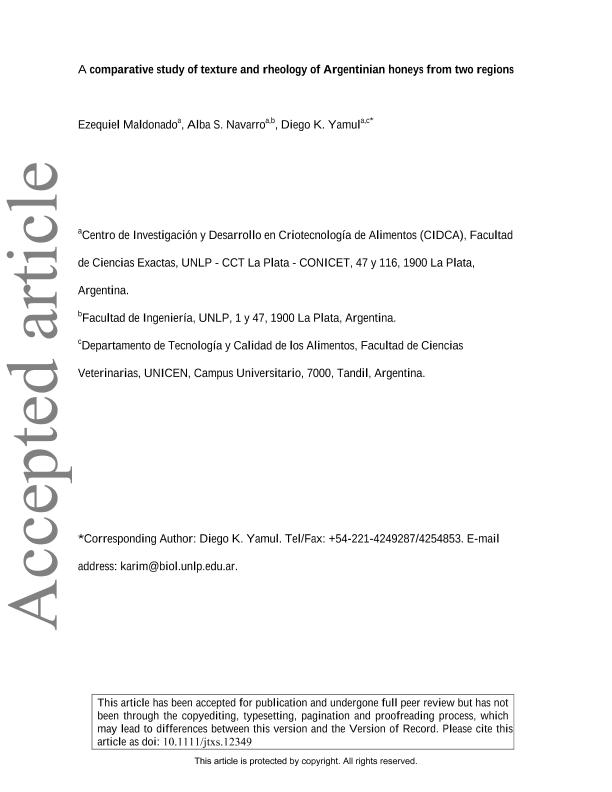Artículo
A comparative study of texture and rheology of Argentinian honeys from two regions
Fecha de publicación:
08/2018
Editorial:
Wiley Blackwell Publishing, Inc
Revista:
Journal Of Texture Studies
ISSN:
0022-4901
Idioma:
Inglés
Tipo de recurso:
Artículo publicado
Clasificación temática:
Resumen
The rheological and textural properties of 26 eastern Argentinian honeys from two different regions (North and Central) were investigated. The viscosity curves of the samples were obtained using a rotational rheometer over a temperature range of 10 to 50C. The viscosity decreased with temperature and all honeys showed a Newtonian behavior. The temperature dependence of viscosity was described using the Arrhenius, Williams–Landel–Ferry, Vogel–Taumman–Fulcher, and Power Law models. The glass transition temperatures of honeys were measured with differential scanning calorimetry and values ranged from −42.63 to −47.71C. The glass transition temperature was also predicted with the Williams–Landel–Ferry model and no significant differences were observed with the experimental results. Rheological parameters were obtained by small amplitude oscillation experiments. Results indicated that the viscous modulus was higher than the storage modulus within all the frequency ranges assayed and honeys from the North region were more viscous. Results of the back extrusion test showed that honeys from the Central region are harder and both groups of honeys (North and Central) exhibited the same consistency and adhesivity. Practical applications: The honey chain production starts with the extraction of the product from the combs, pumping it through pipes and finishes at the packaging of the product. During all these stages, honey viscosity is a key parameter to ensure proper processing and quality control, preventing the waste of economic resources. Determining honey viscosity is of great importance for the industry to select the equipment such as pumps, mixers, filters, centrifuges, heat exchangers, and optimization of industrial processes. The rheological and textural properties of honey are very important in terms of applications related to quality control and authenticity of honeys. Honey authenticity increases the trust of consumers to certified food products. Argentina is one of the leading honey producers and exporters in the world, but information on the rheological, thermal, and textural characteristics of Argentinian honey is very poor in the scientific literature.
Palabras clave:
Honey
,
Rheology
,
Texture
,
Glass transition
Archivos asociados
Licencia
Identificadores
Colecciones
Articulos(CCT - TANDIL)
Articulos de CTRO CIENTIFICO TECNOLOGICO CONICET - TANDIL
Articulos de CTRO CIENTIFICO TECNOLOGICO CONICET - TANDIL
Articulos(CIDCA)
Articulos de CENTRO DE INV EN CRIOTECNOLOGIA DE ALIMENTOS (I)
Articulos de CENTRO DE INV EN CRIOTECNOLOGIA DE ALIMENTOS (I)
Citación
Maldonado, Gerardo Ezequiel; Navarro, Alba Sofia del Rosario; Yamul, Diego Karim; A comparative study of texture and rheology of Argentinian honeys from two regions; Wiley Blackwell Publishing, Inc; Journal Of Texture Studies; 49; 4; 8-2018; 424-433
Compartir
Altmétricas




